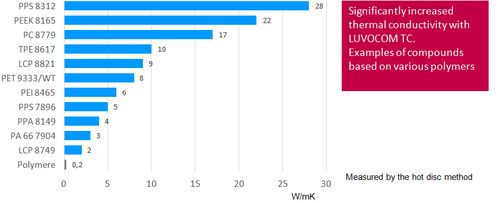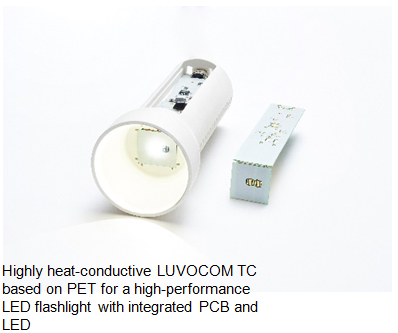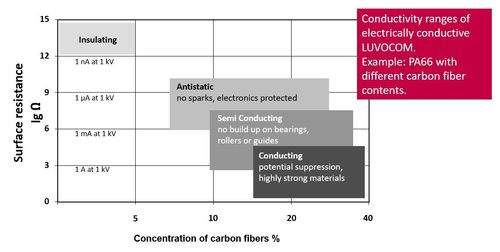
Expertise in Conductivity
 | Product highlights
|
Electrically conductive compounds
Conductive compounds have decisive advantages over metals or coatings: they offer a great degree of freedom in design; the finished parts have a lower weight, are easier and more cost-effective to manufacture and are also tougher. Electrically conductive compounds, at LEHVOSS based on almost all thermoplastic polymers, are produced by adding conductive substances such as carbon fibers, carbon nanotubes (CNTs), steel fibers or graphites. The desired electrical resistance can be adjusted during the process: from 109 Ohm (antistatic formulation) to less than 109 Ohm (antistatic formulation) up to 101 Ohm (conductive materials). The chart below shows examples for PA compounds with different concentrations of carbon fibers.
The typical fields of application for electrically conductive compounds are many and varied. In addition to covers and machine parts for explosion-protected areas, electrical and electronic components, the range also includes casings and functional parts for paper transport (examples include office machinery and cash dispensers). Conductive compounds are additionally used in carriers for electrically sensitive products (electronic components, explosive substances), where statically generated electricity has to be carried away immediately in order to avoid disruption or explosions resulting from spark discharge.
Thermally conductive compounds
Plastics are poor heat conductors. The thermal conductivity of polymers, including those with glass-fiber and carbon-fiber additives, lies between 0.1 and 0.4 W/mK. By including special additives, we are able to supply materials with more than 30 W/mK. You can choose between electrically conductive and electrically insulating products based on almost all available thermoplastic polymers.
LUVOCOM® TC - An up to 200-fold increase in thermal conductivity

Highly sought-after in many industries
Wherever it is necessary to avoid overheating, thermally conductive materials are in demand. In the electrical and electronics industries, the heat dissipation from casings used for coils or housings for hard discs and other mass data storage devices can be increased through the use of thermally conductive LUVOCOM® TC. The geometric design here is extremely flexible: during injection moulding cooling fin structures can be achieved to allow even components with complex shapes to be completely enclosed. In mechanical engineering LUVOCOM® TC is suitable for friction bearings and motor housings. And in the automotive sector, too, there are numerous possible applications for electronics components and lighting.
Thermally conductive plastics bring a shine to LEDs

All over the world the use of lighting systems with LED (light emitting diodes) technology is on the increase. They can be found in applications such as automobiles and living areas. With the requirements of LED lamp manufacturers particularly in mind, Lehmann&Voss&Co. has developed new thermally conductive plastics, which are used here as heat sinks and enclosures. The materials are characterized by a specially adjusted thermal conductivity ranging from 0.6 to 8.0 W/mK, good strength figures, electrical insulation, a white coloration and optional flame retardation, tested to UL94 V0. PET, PA 6 and PC are the base polymers. Thanks to the customized properties of the materials, the lamps achieve a higher performance and service life, while the good processing characteristics permit freedom in design and allow cost savings compared with other materials such as metals and ceramics. In the case of electrically non-conductive materials, conductor tracks can be applied directly to the polymer, making conventional PCBs (printed circuit boards) unnecessary. This allows functional integration and the reduction of assembly steps. An example is the flashlight shown.

